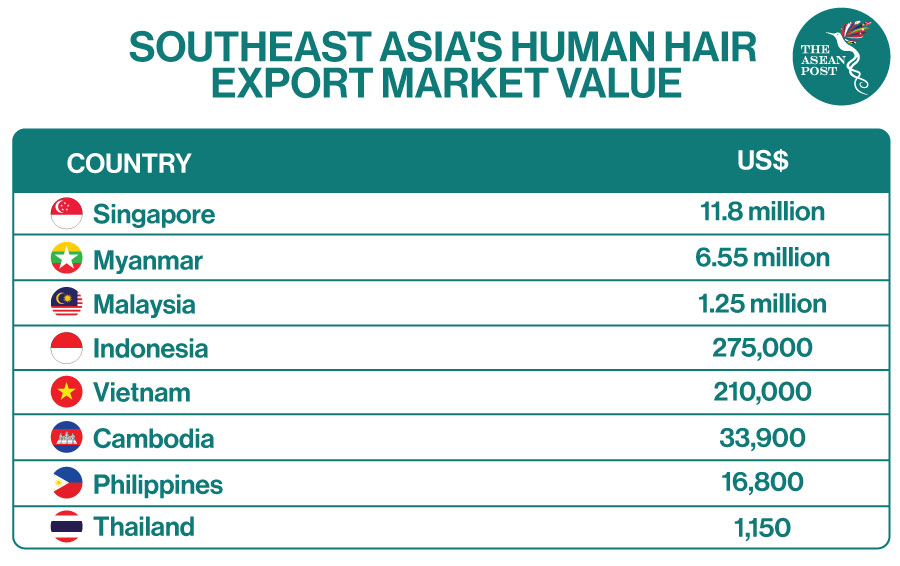In Southeast Asia, long hair is esteemed as a mark of beauty with deep religious and social meaning.
Hair extensions have become an essential segment in the multi-billion-dollar hair industry, with estimated annual sales ranging in value from US$250 million to over US$1 billion. Based on a 2018 Research and Markets report, the global hair wigs and extension market is estimated to be valued at more than US$10 billion by 2023.
Raw human hair has significant commercial value and is a coveted commodity in international trade where it is processed into hair extensions and wigs. According to a report by the Observatory of Economic Complexity (OEC), the global value for human hair exports in 2017 was US$126 million. Asia human hair exports were valued at US$72.4 million, accounting for 58 percent of the overall global human hair trade.
Raw human hair is collected by harvesting directly from the heads of women; and the trade in human hair is a profitable niche market. In India, the Tirupati Balaji temple earns 10 percent of its income through the auctioning of human hair donated to the temple by devotees.

There are three categories for collected hair which are Remy, non-Remy and virgin hair. Remy is usually obtained from temples through donations and is of the highest grade. Non-Remy hair is lower grade hair collected from individuals and the hair is typically broken or short. Virgin hair is hair that has never been chemically treated.
The human hair trade is a lucrative business in Myanmar. In 2017, the ASEAN member state earned US$6.2 million from it. However, the trade in human hair is not regulated across Southeast Asia, allowing traders to source their hair through unfair means.
Exploited
Most traders opt to acquire human hair from India where the hair is usually donated for religious rites. In Southeast Asia, traders target impoverished areas to buy hair from desperately poor people. Their desperation makes them easy prey for exploiters. Hair extensions in the United States (US) can cost between US$500 and US$2,000, but the owner of the hair may only receive a tiny fraction of that cost.
For example, Vietnamese Nguyen Thi Thuy told the media that the highest she has ever been offered for her hair is VND70,000 (US$3). According to a recent article written by Erica Ayisi in partnership with the Pulitzer Centre, titled, ‘Made in Cambodia: How women in poverty are supplying America's market for hair,’ Cambodian women can get at least US$15 for their locks.
Soeng Sen Karuna of the Cambodian Human Rights and Development Association told Ayisi that these women don’t know how to bargain over the price of hair; they “decided to sell their hair because they are poor, and they don’t know where to sell their hair for international market price.”
Sen Karuna explained that if the hair trade were to continue, the government should think about the people and not allow excessive exploitation to take place.
Unfortunately, demand for human hair far exceeds supply. The high value of human hair has made hair-theft muggings a recurrent problem in some countries. A number of companies have also resorted to using fake hair through chemical processing or using a mixture of human and goat hair.
Ethical Sourcing
The increased awareness of exploitation in the human hair trade has forced many companies to collect their human hair from more transparent and ethical sources. For instance, Remy New York – a start-up that promotes fair trade in human hair allows third parties to follow its supply chain and have access to the women whose hair was sourced from to ensure transparency.
The start-up also offers women higher prices for their hair, ranging from US$65 to US$200. After agreeing upon a rate, the founder – Dan Choi, would section and cut the hair himself.
While the human hair trade has provided many communities with incomes and opportunities, practices that exploit and deprive women of opportunities must stop. Regulations and fair trade will empower women to thrive in the industry and perhaps when technology advances, synthetic hair may one day match that of humans.
Related Articles:
